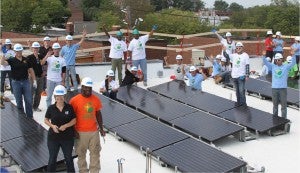
I thought only supervillains like Mr. Burns or Supreme Leader Snoke from Star Wars were bold enough to try snuffing out the sun…I was wrong.
I’ve been writing about solar power and economic equity for eight years now and I still firmly believe the vision that drew me to this issue in the first place: solar and other forms of clean energy hold the potential to be a jobs and economic growth machine for communities who need it the most.
Back in 2008, I joined a collective movement of environmentalists, community and justice activists, and labor and faith groups who coalesced around a vision for the “green collar economy.” The idea of this movement was to fight climate change while also lifting people out of poverty and jails, and helping them transition into promising careers in growing industries.
Since then I’ve seen many great strides in the creation of a clean energy economy that employs hundreds of thousands with well-paying and accessible jobs, propelled by smart policy, innovation, and upstart private and public sector players, all making meaningful investments in communities. Rooftop solar in particular has begun to challenge the status quo by turning people’s homes into mini power plants, cutting into dirty power and the monopoly-dominated, electric grid.
Yet, despite this progress and opportunity, some states – fueled by short-sighted officials, fear-mongering, and the threat of declining profits for big business utilities – want to shut it all down.
The battle over rooftop solar is happening right now in states like Nevada, Arizona,Florida, and even the solar giant California, where existential threats to local, clean, distributed energy from the sun are beginning to surface. Utilities want to continue to operate as monopolies and build massive infrastructure to meet our energy needs – with rate payers footing the bill – because that is how they make money. This business model runs contrary to ones in which customers produce, store, and use their own solar power.
[Tweet “The Sun Belongs to Everyone”]
I saw this battle, and its casualties, first hand last week in Nevada. The desert state used to be a shining beacon for solar power, boasting the most solar jobs per capita in the country, which was helping to boost an economy ravaged by unemployment and the collapsed housing marking of the Great Recession.
The Solar City warehouse I visited in Las Vegas used to complete 1,200 solar installs per month and employ hundreds of people. Now, the warehouse is almost empty, and statewide solar applications have plummeted 93 percent after the introduction of policy specifically aimed at curbing rooftop solar. Over a thousand solar workers, nearly 17,000 households who made the decision to go solar, and anyone in the state who wants to tap the power of the sun for their home, are now effectively pushed out of the solar market.
This begs an important question: who owns the sun, and why do some utilities think they do?
Last I checked, the sun belongs to everyone. Moreover, everyone’s ability to access it keeps getting easier, with prices expected to fall another 40 percent in the next two years. The cost of energy storage and electric vehicles that will allow us to charge during the day and power our homes at night is also becoming more affordable; so is the cost of technology like advanced thermostats and other smart devices that can charge and operate when sun power is plentiful.
We still have a long way to go to make solar accessible and affordable for all communities, especially low income households and communities of color.
And those monopoly energy companies? A recent study found that rooftop solar will have significant impacts on utility shareholder profits – up to a 40 percent loss for some.
This isn’t to say that rooftop solar is a panacea for equity. We still have a long way to go to make solar accessible and affordable for all communities, especially low income households and communities of color, who are oftentimes exposed to the worst pollution and can least afford new technology in their homes.
It also doesn’t mean all utilities and regulators are bad. I have been encouraged to see some utilities (in this case, municipal utilities like Los Angeles Department of Water and Power and CPS Energy in San Antonio, Texas that are owned by ratepayers and not investors) actively working to expand community solar and “solar leasing” programs.
Rooftop solar needs to be treated as part of the solution in decarbonizing the grid and a compliment to utility-scale clean energy and other meaningful programs that bring us closer to a clean energy future that can be accessed by all.
After all, nobody owns the sun; it’s for everyone.
Photo source: Grid Alternatives
This post originally appeared on Huffington Post.









